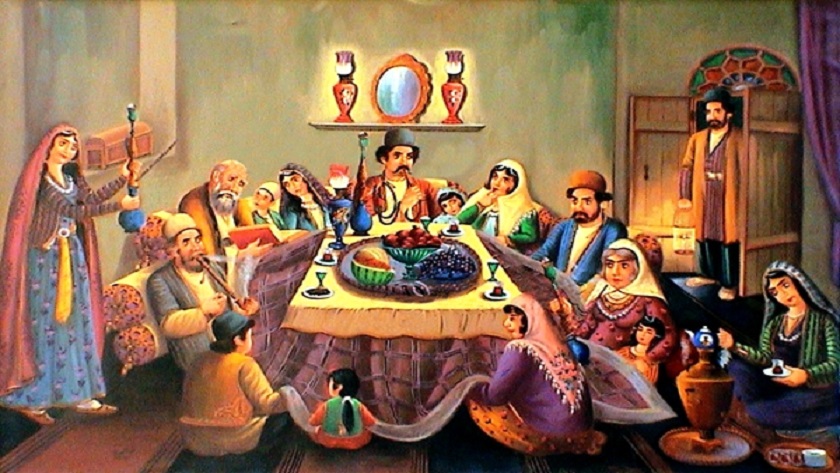Iran is one of the oldest countries in the world. Usually, being a country with centuries of history behind it means having lots of celebrations, ceremonies, and customs being held annually.
 Painting depicts Yalda celebration
Painting depicts Yalda celebration
Shab-e Yalda (Yalda’s night) or Shab-e Chelle is the Iranians’ way to confront the coldest season of the year. This Iranian festival, which is celebrated every year on the night of December 20 or 21 in the Gregorian calendar, has a very long history and is among the most important Iranian festivals and ceremonies.
Historical backgrounds
The history of Shab-e Yalda dates back to Zoroastrian tradition when the darkest and longest night of the year was considered an unfavorable date and so, people needed to protect themselves from evil.
 Yalda celebration is an old Persian tradition
Yalda celebration is an old Persian tradition
It is also worth mentioning that the word Yelda in Arabic means dark night, and as Persian and Arabic languages have many words and traditions common between them, this name may also be referring to the whole concept of this traditional Persian celebration.
Some estimate the antiquity of this ceremony to be more than 7000 years. However, Shab-e Yalda was officially introduced into the ancient Iranian calendar in the year 502 BC by Darius I. Yalda is derived from a word in Syriac language meaning “Birth”.
 Pomegranate is served at Yalda celebrations
Pomegranate is served at Yalda celebrations
It is quite an ironic name for a date when darkness dominates the night longer than any night in the year, but it is full of hope and meaning at the same time. In fact, people of ancient times, including Aryan tribes from India and Iran, India and Europe, realized that the shortest days are the last days of autumn and immediately after the first night of winter the days gradually get longer and the nights shorter, so they called this night the birth of the Sun (Mehr) and considered it as the beginning of the year. Some believe that Christian Christmas also has its roots in this belief.
 Reciting Hafiz at Yalda
Reciting Hafiz at Yalda
Hafiz reciting
Almost all Iranians keep a copy of Hafez’s book of poems called Divan at their homes. It’s the great Hafez who steals the spotlight of most of big celebrations. The eldest member of the family recites poems from Diwan of Hafez– diwan is a collection of poems by a poet – with a Sufi tune in the background, creating a spiritual ambiance.

Yalda Ceremony
Broth, sweets, dried fruits, and nuts that are used specifically for the occasion are also set on the table and consumed during the gathering.
 Iranian children celebrate Yalda while learning its cultural significance
Iranian children celebrate Yalda while learning its cultural significance
Fruits are an essential part of Yalda festivities. Pomegranates occupy the most important place on the table – symbolizing rebirth and revival. Melons and other fruits signify fertility, light and goodness.
A food indigenous to Iran, pomegranate is believed to be a symbol of life and resilience, for it blossoms during the harshest climate of winter.
 Fruits, nuts and confectionary are among Yalda festivies
Fruits, nuts and confectionary are among Yalda festivies
There is an ancient myth saying that eating watermelon on Yalda night makes the person immune to cold winter weather as well as the next summer’s heat. In old times summer watermelons were buried under branches and leaves in a cold place to keep them fresh until the Yalda night.

Yalda, or the Winter Revolution; the last day of autumn, whatever you name it, is a traditional celebration of all the people to keep alive the longest night of the year.
The ancient fiesta is widely celebrated in Iran, and even by Iranians living overseas. It is also popular in neighboring countries like Afghanistan, Tajikistan and Azerbaijan.
Ashkan Salehian

